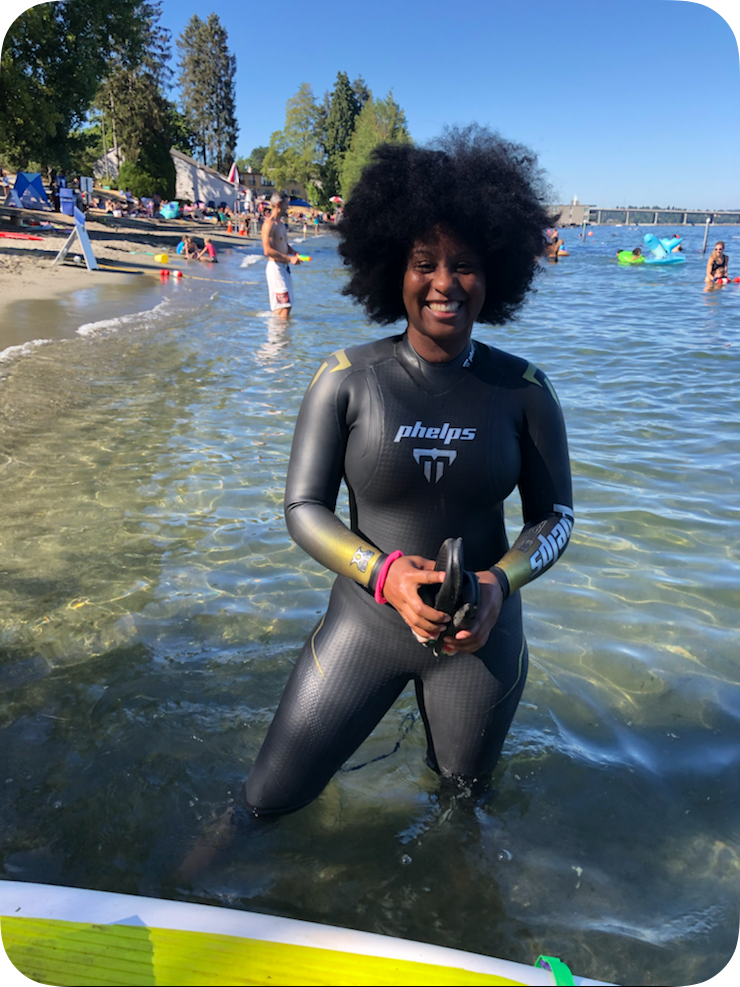Growing up, I have always had a fascination with water. Anytime I was near or in water, there’s a peace that I experienced. It was a coping mechanism. This was even before I knew how to swim traditional strokes with good technique — I just loved being in the water.
But before I created Afroswimmers, I was unable to find an active Black community online where people come together openly to share their stories in aquatics. So I started Afroswimmers to spread that message to other Black Americans.
Since the murder of George Floyd, the conversation about diversity has come to the forefront. I’ve seen an overwhelmingly positive response from white people in the aquatics community who say, “We recognize that there’s an issue, and we want to be part of the solution. We want to welcome more diverse swimmers, but we don’t know where to start. Where do we go?”
The Power of Representation
When building diversity within aquatic sports and the aquatics arena, I believe the most important step, and your first step, should be creating representation within your program.
This is important because people need to see themselves active in the sport. Research shows how important representation is and how people are more inclined to learn when they see somebody who looks like them or represents them culturally. But the issue with swimming is that we do not have those images of Black and brown people being promoted in aquatics. Very rarely, we might get a photo of Olympians like Simone Manuel, Cullen Jones and Lia Neal. We’ll see these images in February, which is Black History Month. After that, it goes back to being portrayed as an all-white, male-dominated sport.
Because Black people don’t see enough representation, we are not motivated to choose swimming as an option. But when we see others lead the way — when other people overcome the many obstacles that culturally Black and brown people face in aquatics — we see that as an opening, a possibility that creates a domino effect of curiosity.
I’ve noticed that on the Afroswimmers Instagram account, which shows my journey in open-water swimming. I started getting tagged, with several photos and videos of other swimmers who said, “You know what? If Coach Noelle can swim in open water, I can do it, too.” It’s almost a follow-the-leader effect.
For others, this representation reveals the power of stereotypes. Most people who participate in aquatics have heard the stereotype that Black people don’t swim, have denser bones or don’t want to get their hair wet. These are generalizations, not facts. Seeing contradictions to these stereotypes challenges your perceptions, whether you’re a person of color or not.
Social Strategy
Representation — which shows that you are creating a welcoming space for people of other races, nationalities and cultures — is the start to building a diverse program. I believe the best place to do this is through social media.
Conversations about race are not taking place at our dinner tables or the workplace. It is happening through social media. We’re seeing all these amazing movements that are being manifested, and it’s very powerful.
The first thing to do is review the message that your social media pages send about where you stand in the movement of diversity and aquatics.
Social media tells a story. It shows people all over the world, who you are, what you like to do, and what’s important to you. If you have an aquatics program, and most or all the images on your social media page only include white people, I can assure you that Black people are not looking for your organization as a resource. This is because you’re not sending the world the message that you are inclusive, that you celebrate diversity and equity in your programs. Even if that’s who you are in your heart, at your core and in the mission of your organization, that’s not the message that’s being relayed to the world.
But you can represent people of color, even if you live in a predominantly white, rural town where there isn’t a lot of diversity. You can reach out to other local initiatives in other states. For example, if you have a predominantly white swim program but believe that swimming should be accessible to everyone, you can go online and intentionally search for programs that promote diversity in aquatics. You can Google this, look through hashtags, or even look this up by location. Once you find these organizations, you can reach out to them and say, “I love what you are doing. We don’t have a lot of diversity in our town, but I want to support your initiative. Can I reshare this photo, to just encourage more people to participate in aquatics and tell more people about what you’re doing in your area?” Nine times out of 10, that person will reply with an, “Absolutely. How can I help you?”
Among those of us who use social media, these conversations are already happening in our DM’s, or direct messages from coaches, aquatic directors and organizational staff. By resharing an image or video, you are now promoting the diversity that is taking place in that other city to all of your followers, and you’re telling them, “We support this image.”
So even though you don’t have any Black folks in your area, social media helps to overcome that limitation and barrier by allowing you to connect with anybody in the world and support them – all by sharing a picture. It’s that easy.
Venue for Healing
The world is not all white, it’s not all Black; it is not all Hispanic and Latino. It’s a melting pot, and we should be able to celebrate these differences. Swimming is the perfect place to do that, and to have these conversations about diversity and inclusion, because aquatics brings people together, and it heals.
